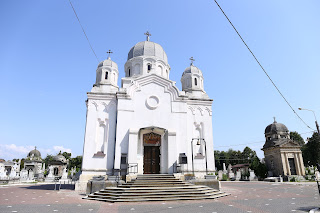
About the cemetery
The “Eternitatea” cemetery was established by the City Hall of Galati following the implementation of the Law for burials, which was issued in 1865 by the Government led by Mihail Kogalniceanu; it claimed that no cemetery should be built next to churches and monasteries, but at least 200 meters from the outskirts of cities.
Construction began in 1865. There are two buildings, with one of the rooms being intended to serve as an Orthodox chapel. The cemetery systemization plan included from the very beginning a particular place for the construction of a church. In May 1866, the building where the temporary chapel was set to function was already raised with the roof having been installed, but it still needed the flooring installed and the walls plastered.

The cemetery - with a total area of 22 hectares - was divided into 9 plots proportional to the following religious denominations: Orthodox, Catholic, Calvinist, Protestant, Armenian, Lipovan, Muslim and Jewish. The ninth plot was intended to be used for suicides.
The consecration of the graveyard church, dedicated to the Assumption of the Blessed Virgin Mary, was celebrated in February 1913. Near the Church, there are graves belonging to notable personalities, which stand out for both their artistic and historical-monumental value.
The "Eternitatea" Cemetery is also the place where monuments were built in memory of Romanian and foreign heroes who fell on the battlefield in World War I and World War II, but also during the Romanian Revolution of December 1989. The most imposing monument is the Heroes Mausoleum, followed by the Romainian Heroes Memorial, French Heroes Memorial, German Heroes Memorial, Soviet Heroes Memorial.
Important graves and monuments
Heroes Mausoleum
The Heroes Mausoleumwas built in honor of the Romanian heroes who fell on the battlefield in the Romanian War of Independence (1877-1878) and in the First and Second World War. The mausoleum was built between 1925-1927, according to the plans of Mihail Popescu, chief architect of Galati City Hall at the time.
World War II Heroes Memorial (1941-1945)
By the eastern end of the cemetery, we encounter the Heroes Memorial, which was designed by sculptor Gheorghe Terescenco. It has the shape of an approximately 6 meters tall rectangular column, built using reinforced concrete and covered in marble. At the top of the column there stands a 2 meters cast stone eagle with its wings spread holding a cross in its beak. The monument was inaugurated on October 25, 1997.
 The 1989 Romanian Revolution Heroes Memorial
The 1989 Romanian Revolution Heroes Memorial
In front of the mausoleum, next to the French heroes’ graveyard, we encounter the Graveyard of the Heroes of the 1989 Romanian Revolution. The memorial, in the shape of a white marble obelisk was designed by architect Aurel Pop and built in 1990. The inscription reads ”Honor to our heroes”.
The French Heroes Graveyard
The graveyard of French heroes is located to the west of the Heroes Mausoleum. Here lie the remains of 61 French soldiers and 9 Algerian soldiers who were part of the Berthelot mission. The graves of French heroes are guarded by swords in the shape of a cross, while those of Algerian heroes are adorned with monuments displaying Arabic inscriptions.
 The German Heroes Memorial
The German Heroes MemorialIn the eastern part of the cemetery we discover both the Memorial and the graves of German War heroes, with an imposing granite cross in its central part. Some interesting words can be read here by passers-by: "Remember them and the victims of all wars, their fate compels us to understanding".
The Soviet Heroes Memorial
In the central part of the cemetery we encounter the Memorial and graveyard of the World War II Soviet Heroes. Built in the shape of an obelisk, the monument displays an inscription which reads: "Eternal glory to the soldiers of the Soviet army who gave their lives in the fight for the liberation of humanity from fascist slavery", written in both Russian and Romanian.
Public figures burried in ”Eternitatea” Cemetery

- Charles Cunningham (1801-1860): the former vice-consul and later consul of the British Kingdom in Galati and Braila.
- Vincenzzo Fanciotti (1824-1886): the owner of a commercial house that exported grain and contributor to the construction of the "Alexandru Ioan Cuza" Commercial School.
- Gheorghe Fulger (1832-1899): a large rural landowner and merchant, president of the interim commission and mayor of Galati from March 1883 to April 1884, member of the county committee, elected to the Fourth College in February 1880 and candidate for the Romanian Senate in 1888.
- Aristide Papadopol (1838-1917): a rich merchant who remained in the history of Galati not through his pecuniary wealth but through his love of art.
- Ioan D. Prodrom (1867-1952): a philanthropist and politician from Galati.
- Nicolae Mantu (1871-1957): one of the most appreciated Romanian painters
You can find more about the important graves, monuments and public figures burried in ”Eternitatea” Cemetery HERE.
Cemetery location
221 George Cosbuc Street,800552, Galati,
Romania
Cemetery contacts
Ionuț Pucheanue-mail: ionuț.pucheanu@primariagalati.ro
phone: +40 0236307700
Vergiliu Vals
e-mail: vergiliu.vals@primariagalati.ro
Cristi Ochiu
e-mail: cristi.ochiu@primariagalati.ro
Cristina Zanfir
e-mail: cristina.zanfir@primariagalati.ro
Basic cemetery data
Managing organization: City Hall of GalatiOwnership: City Council of Galati
Number of graves: 26.684
Cemetery size in m2: 213.996 m2
Cemetery type: religious, military

